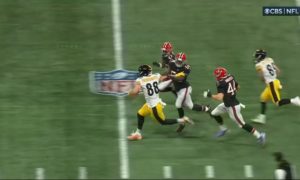Here is something that is interesting, although perhaps not terribly surprising: on the Pittsburgh Steelers’ 41 official runs during Sunday’s game, their newest tight end, Vance McDonald, was a frequent presence, seeing 21 of his 30 total snaps on those plays.
Not that Jesse James was absent, by any means, although on 11 of those 41 runs, McDonald was on the field while James was not. The third-year tight end is still undoubtedly seeing the lion’s share of the snaps, and I’m not sure if there is a compelling reason to anticipate seeing that change at any point this season, as of yet.
But McDonald did play significantly more on Sunday than he did in the opener—obviously sitting out the second game of the season—so perhaps the Steelers are beginning to get him more and more involved in the offense. He still saw about half the snaps as James.
What is interesting though is that, as developed late in the season a year ago, the Steelers are developing a tendency to move away from James when they go to run-heavy looks. The Steelers ran 10 plays on Sunday with a fullback and one or fewer wide receivers on the field, and James was only on the field for three of them, one being a pass. McDonald was there for nine of the 10.
In all, they ran 24 plays with two or fewer wide receivers. James was on the field for 14 of them, while McDonald was on the field for 22 of them.
As was also the case last week, the Steelers did seem to have an interest in being varied early, showing a number of different looks, including a lot of two-tight end sets. McDonald actually started the game in Baltimore with B.J. Finney as a tackle-eligible and Roosevelt Nix in as a fullback, with James on the sideline.
On the Steelers’ 17-play opening drive, McDonald saw 11 snaps, James nine. Eight of his 30 total snaps also came out of the 11 personnel package as the lone tight end on the field, and they produced four plays of 15 yards or more, two of them coming via the pass and two via the run.
Most telling is the following statistic: of the 21 running plays on which he was a participant, the Steelers averaged a gain of six yards. This included three runs of 15 yards or more, one of them an explosive play, and just one of the team’s five negative rushes.
Comparatively, on the Steelers’ 30 running plays with James on the field, they only averaged three yards per carry. Even if you factor out a personal foul penalty that gets mixed in there, that only boosts the average up to 3.2 yards.
Whether this is a substantial statistic or an anomaly will require a much greater sample size over the course of several games, but McDonald did play well as a run blocker, and that is something that I will highlight later this week in a film session.








